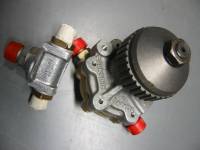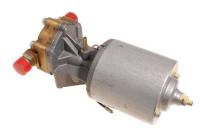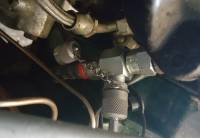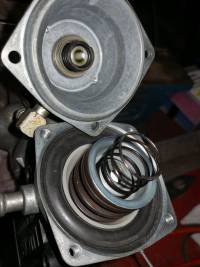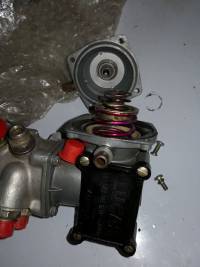Table of Contents
Lucas fuel injection
From the tank to the injector….
Lucas mechanical fuel injection leaves plenty of room for improvement…
On the one hand for reasons of age: At some point every spring, every rubber seal fails once…Every pump gets tired..
On the other hand, due to the design…The carts were not built for driving for hours on end over mountain passes in the Dolomites after 40 years at >35° outside temperature and cloudless skies…
For various reasons, cavitation occurs in many “standard conversions” with current pumps, so that no more gasoline is pumped…
The pumps are usually oversized, which means that the gasoline is pumped in a circle with an enormous volume flow and heats up in the process…
Together with tank connections that are far too small for the quantity pumped, that's it quickly….
Tank outlet & filter:
Even if I am now of the opinion that it is superfluous, I installed an extended tank outlet at the time…
A Mahle KL27 is generally recommended as a filter:
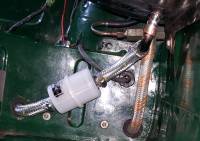
Fuel pump:
The fuel pump…a subject full of misunderstandings…in the truest sense of the word!
Originally used in racing (rally and Formula 1), the mechanical Lucas PI injection was adapted to road vehicles…. at a time when COST SAVING was a top priority because sales figures were plummeting… The TR5 (PI), which is so popular today, was replaced by the TR6 after less than two years of production for good reason…
And to save money, every means was right: For example, the mechanical, belt-driven fuel pump of the racing engines was saved and only the electric “auxiliary pump”, which was only used to start racing cars, was used permanently…
They reached into Lucas' shelves and found a windshield wiper/fan motor, which was used in a slightly modified form. Now we had an electric fuel pump!
Lucas pump
On the one hand, it was good because it did not release any heat into the fuel during operation (keyword: vapor bubble formation), but at high temperatures it quickly reached its limits due to the lack of cooling and failed… Not to mention the limited service life (~60,000 km)… But who expects that a few crazy people will still want to drive these things after 50 years….
Back in the 70s, resourceful mechanics came up with the idea of using a Bosch pump with the right pressure, flow rate and power consumption, which would last longer and - as it is fuel-cooled - would not fail…
And now the dilemma: this beautifully fitting pump is no longer manufactured! Because today's vehicles have completely different pressure requirements… direct injection engines work with 3-digit pressures, “normal” injection engines only with 3-4 bar…
Everything that the dealers offer us as an “uprated Bosch fuel pump” or from Pierburg/Sytec for expensive money is clearly overshooting the mark in terms of pressure, flow rate and therefore power consumption… (Old: 5 amps, new: 15 amps!) Bosch as well as other manufacturers only offer pumps which - if designed for >=8Bar - deliver flow rates >150L/h… (The original had something like 80L/h)
This means that these gasoline-cooled! This leads to these gasoline-cooled pumps giving off more than 120 watts of “power loss” as heat to the gasoline… For short trips to the next classic car meeting, this leads to cavitation at higher temperatures/longer trips/lower pressure (Alpine passes) and thus a drop in pump performance to “0” bar…. technical term:
VAPOR BUBBLE FORMATION 
Modern pump:
So here is the misunderstanding: The old chemist's motto does not apply: “A lot helps a lot!” but rather: “Less is more!” Less heat input → more fun in the Dolomites!
Far too much gasoline is pumped at too high a pressure, which then only flows back into the tank after the fuel pressure regulator (PRV)…heated by a few degrees…and that really heats up the tank for hours!
Solution:
Either relieve the old Lucas pump with a suitable pre-feed pump or find a pump that fits exactly… As off-the-shelf pumps are only available for a lot of money from e.g. www.prestigeinjection.com, my tip would be:
A combination of a feed pump, e.g. Pierburg E1S (7.21088.62.0), which belongs in a catchtank and a Pierburg E2T (e.g. 7.21287.53.0).
Further information:
http://www.lucasinjection.com/bosch_and_lucas_fuel_pumps.htm
https://kinsler.com/Shop/lucas-mechanical/
http://www.pierburg-service.de/ximages/pg_pi_0034a_de_web.pdf
Or even better: Adapt the pump output to the requirements using a PWM controller… If you set the pump output so that the return flow from the PRV → tank is 1-1.2 L/min at idle, you should be on the safe side and have reduced the heat input into the gasoline to a minimum…. and the tank outlet can also let out enough gasoline again…
Suitable PWM regulators with 6-90 Volt / 15A load capacity are available on Ebay: https://www.ebay.de/itm/175785628034
Measure the pressure:
In order to be able to measure the fuel pressure at the front of the metering distributor, I ordered suitable parts:
T-piece:
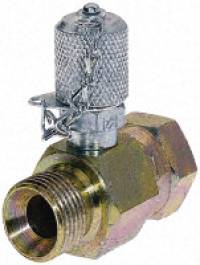
https://www.rs-online-privat.de/Products/ProductDetail/1dcd8c41-ed26-41cf-90c3-744dfb75097e
Manufacturer Hydrotechnik Prod. Part no. SNA02
Connection hose:
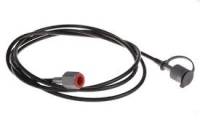
https://www.rs-online-privat.de/Products/ProductDetail/1dcd8c41-ed26-41cf-90c3-744dfb75097e
Hydrotechnik connection for hydraulic measuring points, S110-AC-FA-01.00, connection A: M16, connection B: G1/4, L.=1m
Pressure gauge:
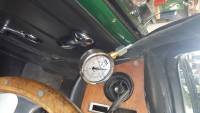 https://www.rs-online-privat.de/Products/ProductDetail/df78688f-2cd5-4298-9709-abfad79d1ce8
https://www.rs-online-privat.de/Products/ProductDetail/df78688f-2cd5-4298-9709-abfad79d1ce8
Sferaco pressure gauge analog 0 → 10 bar, Ø 63mm G1/4 stainless steel..here you can also take any other glycerine-buffered pressure gauge with G1/4“ connection on Ebay…
For installation, the screw connection at the bottom of the frame of the thick fuel line to the supply hose must also be loosened…so disconnect it in the trunk beforehand… The whole process takes 10 minutes… and costs 87,-€ incl. shipping at RS-online…
Now you can connect the pressure gauge while the engine is running and measure while driving….Pressure-resistant up to 400 bar (pressure gauge up to 13)
Metering distributor:
DV: There's not much to say here: You can only repair it yourself if there is no rust in the system… Tip: If you don't ride much, you should add 200-300ml of 2-stroke oil when refueling….DV + jets will thank you! Adjustment: It's a science in itself…I might write a separate page on this… There are two specifications: For the 126hp (CR) models and for the 143hp models… As the other camshaft of the CR generates more vacuum from the engine, the CR metering distributor has 3 springs…and the largest one is also much more stable…CP only 2
The amount of fuel is determined by the height of the “threaded towers” and thus the ratio of vacuum ↔ spring tension…
Check valves:
The six non-return valves to which the hoses are screwed are located on the DV…These must be tight, otherwise the car will start poorly and may run too lean..
Test: Switch off the engine, wait 30 minutes and then pull the nozzles out of the intake manifolds. If you now carefully pull on the tip of the injector, gasoline should squirt out…if not, the pressure is gone and usually the check valve is leaking.
You can overhaul them (at least those of cylinders 1,3,4 + 6) by removing the spring and carefully removing burrs from the rubber plate with 800 sandpaper…then they should seal again…
Install with plenty of (bearing) grease and without damaging the rubber seals!
Lines:
The original lines are still the best…. Some people like the steel flex lines, which were also installed on my bike, better…but they are too large in inner diameter → too much fuel has to be moved during the injection process and the amount of fuel cannot be adjusted properly…the Lucas injection system is a precision mechanical gem…some people also say “bitch!”
Jets:
I'm a fan of the original …. although there are people who swear by the Bosch injectors …. but these are simply built for a different application: Whereas with Lucas the injection quantity (at the same pressure) varies in a pulsating manner, with Bosch the pressure is changed… Lucas: 4000 rpm = 2000 valve openings, 2000 valve closings Bosch: open 1 time when starting the engine, close 1 time when stopping…in between the pressure is changed…
It shows the quality reserve with which Bosch worked, if the things still work…

